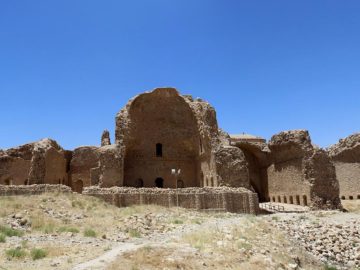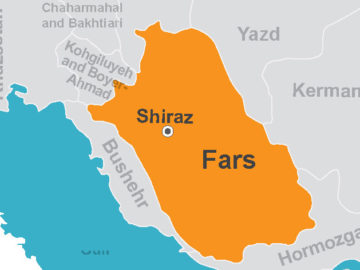
The Palace of Ardeshir, Firouzabad – Fars, Iran
Photo By Hamed Yeganeh/shutterstock
The archeological landscape of the Sassanid era in Fars region is composed of three historical-geographical areas of Bishapour, Firouzabad and Sarvestan. It’s the twenty-third Iranian landscape registered on UNESCO’s word heritage list and the fourth internationally-known site of Fars province.
The Sassanid axis of Fars region includes three cities: the Bishapour historical area includes Bishapour city, Khandaq, the Valerian Palace, the Temple of Anahita, the fortification, monumental pillars, the historical bath, the fire temple, the ceremony hall, the Sassanid entrance, the Sassanid bridge, the mosaic porch in the Bishapour historical site, Ghale Dokhtar, Shapour cave, and Sassanid inscriptions in Chogan Strait. The historical site of Firouzabad includes the historical city of Firouzabad, the Ardeshir Palace, Ghaleh Dokhtar, the Mehrnersi Bridge, and stone inscriptions dating back to the Sassanid era. The historical city of Sarvestan includes the Sarvestan monument.
The Historical Bishapour Site
1) The city of Bishapour
the city has been founded by the second Sassanid king, king Shapour I (242-272 AD). It is located in the eastern part of Bishapour plain, 18 km northwest of the city of Kazeroun. It is some 155 hectares wide and was considered as one of the five administrational centers of Fars in the Sassanid era.
Natural traces have been used to pinpoint the boundary of the city in the north and the east. The Shapour River runs from the east to the west of the plain and marks the northern border of the city. A moat runs around the rest. The city is originally planned like a rectangle with streets that cut each other vertically. There were four gates at the sides of the city. Two main streets were used to connect the gates in one direction. The streets met in the center of the city. There were two main walls, each seven meters high, around Bishapour.
- The Valerian Palace
The exterior of the entrance is made of polished stone. The stones have been tied together using iron holders. The structure is essentially Sassanian in nature. It has a huge gate. All the interior walls are covered with polished stones. The exterior has been painted white. There are designed with plaster pieces everywhere. Some of their most beautiful ones are kept at the Bishapour Museum. French archeologist Grischman believes that King Shaour I had ordered the palace to be built for captive Roman emperor Valerian. This shows the king’s kindness towards the emperor in jail. - The Temple of Anahita
a rectangular building with 14-meter-long walls. Simple stones have been used in building the structure and polished ones are used to design the interior. The building is covered with wooden logs. There were brooks running through the building in the past. That’s why the temple was associated with Anahita, the goddess of water in ancient Iran. Now it’s been learned that the place was used as a cleaning area that people entered before going to fire temples. - The Fire Temple
it’s a cross-shaped building that joins in the center, where there’s a narrow passage. The building has two entrances. Unpolished stones have been used in the central part of the building. There’s a dome, some 20 meters wide, in the central part. It’s probably the biggest dome built in the entire Sassanid era. - The Fortification
research says the city had two main fortification walls, each at least 10 meters high. The first fortification wall surrounded the royal arena and the other bounded the whole city. The thickest wall of Bishapour was some 7 meters wide and encircled all the neighborhoods. - Monumental Pillars
there are two pillars more than 6 meters high placed in the heart of Bishapour city. The two are based on two-step-high platforms. There are two stone inscriptions, one in Pahlavi Ashkani language and the other in Pahlavi Sassani. They’re carved on one of the pillars. The inscription explains about how the city of Bishapour was founded. - The Bath
it’s an octangular building, 100 m2 wide. It has three entrances. Stone and plaster are the two main materials used in constructing the building. Mixed tin and plaster has been used in the walls. - The Ceremony Hall
the hall has four porches covered by a huge dome some 23 meters high. There are passages that lead to the hall and the entrances join these paths. 64 shelves have been built in the hall. All of them are ornate with plaster and painted in bright colors. This hall was used for holding ceremonies, memorials and celebration parties.
2) The Historical Chogan Strait

Shapour cave and Shapour I’s statue, Bishapour – Fars, Iran
Photo By Kenneth Dedeu/shutterstock
- Shapour cave and Shapour I’s statue
Shapour cave is located in the hills right of Shapour River. Nowadays 230 steps have made it much easier to reach the entrance of the cave. The entrance to the cave is some 16 meters high and 30 meter wide. The interior of the cave looks like a huge hall. It gets narrower, sloppier, and shorter in height as one proceeds into it.
The statue of King Shapour I is the most important statue left from the Sassanid era (226-625 AD). It is six meters high and the the shoulders are two meters wide. It’s been carved out of a natural stalagmite inside the cave. The head of the statue (wearing a jagged crown) and the upper part of the body have been preserved. Much of the rest of the statue, including the hands, have been destroyed.
Firouzabad
1) Ardeshirkhoreh
the remains of the city are the most important Sassanian structure in Firouzabad plain. Historical texts say much of the plain was a lagoon before the city of Ardeshirkhoreh was built there. King Ardeshir I ordered the lagoon to be dried out to build the city there. Then the king partitioned the lands and brought water into it from Tangab river. This way, agriculture spread in the area.
Ardeshirkhoreh has a circular plan with a diameter of 1950 meters. The interior part of the city is like a wheel. It’s been divided into 20 huge similar areas using ten streets. The city center is itself another circle with a diameter of 400 meters. Streets are linked to this area. This circle was the official place of administrative, ceremonial and ritualistic buildings. Homes and business were located in the larger circle. There were four gates at the end of the main axis of the city. The city’s fortification wall was built of blocks. A 35-meter wide moat used to encircle the wall.
It should be noted that four-dome building plans were first invented in that era and later became the most notable achievement of the era developed during the rest of the dynasty.
Ardeshirkhoreh’s circular plan that was focused on a center was a symbol of Ardeshir’s ideal way of administration because it resembled the king sitting in the center and the other layers of power around it.
There are remains of a building called Takhtneshin in the city. Takhtneshin is said to have been a four-dome structure with the biggest dome in its central part (14 meter diameter). The place must have been Ardashir’s fire temple as cited in the book of Ardeshir Babakan’s record and other historical sources. It should be noted that four-dome building plans were first invented in that era and later became the most notable achievement of the era developed during the rest of the dynasty.
2) The Palace of Ardeshir

The Palace of Ardeshir, Firouzabad – Fars, Iran
Photo By Hamed Yeganeh/shutterstock
is the second most important Sassanian building in Firouzabad plain after Ardeshirkhoreh. Locals call it the fire temple sometimes. It is located in the northern part of Firouzabad plain, two kilometers away from the city of Ardeshirkhoreh. There are no towers or fortifying walls in the palace. It shows the building was built at a time that there were no need to protect the area from enemies. The palace was the official residence of the king outside the city. Nowadays, farms and a cemetery have encircled the palace.
3) Ghale Dokhtar
was a strong fortress used to block invasions in the valley of Tangab. When we compare the castle with those in Firouzabad plain we understand that it was built by founder of the Sassanid dynasty, Ardeshir Babakan. He defeated Parthian king Ardavan V in 224 AD and then built the castle.
The castle has two parts: the residential area and the royal part. The residential part is located inside a wider wall. The castle is simple but beautiful at the same time.
4) Stone Inscriptions
there are two stone inscriptions in Firouzabad. One tells the story of Ardeshir Babakan’s coronation (he founded the Sassanid dynasty). The other narrates the way Ardeshir defeated the last Ashkanid king Ardavan V.
Sarvestan
Sarvestan Palace is 13 kilometers south of the city of Sarvestan, in the middle of Shiraz-Fasa road. Locals call it the palace of Sasan or the four-dome building. But it’s generally known as Sarvestan Palace. The purpose of building the palace has been a controversial issue all the time.
The plan of the building shows a main porch, which forms the backbone of the palace. It leads to a rectangular hall with a dome above. Clay blocks have been used to build the structure. Inside the building and in each room’s corner there are twin short columns built on small walls. One can see large shelves and semi-circular shapes all along the walls. Archeologists say the palace dates back to the mid-Sassanid era (5th century BC). They particularly relate the building to king Bahram V and say his minister Mehr Narsi ordered the building of the structure. Large rocks, stones, and a mixture of plaster and lime have been used in the building.



